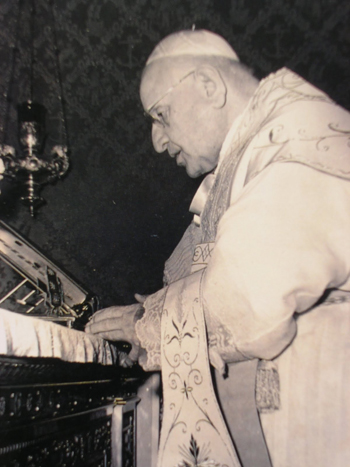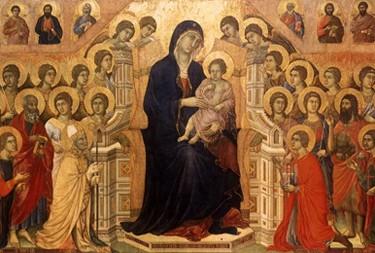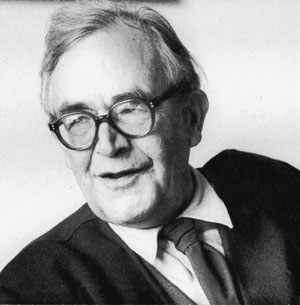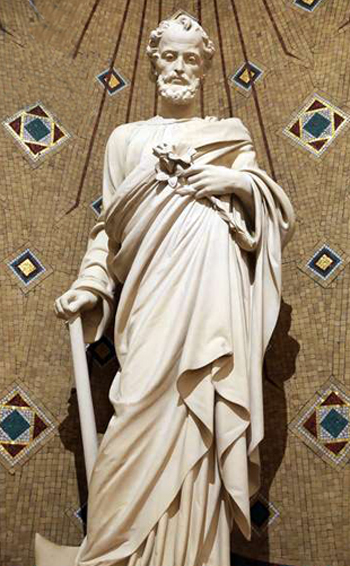Traditionalist Issues
 |
 |
 |
 |
 |
 |
 |
Dialogue Mass - LXXX
St. Joseph in the Canon:
An Innovation to Break Tradition
Pope John XXIII’s decision to insert St. Joseph’s name in the Communicantes of the Canon of the Mass was the first of the Vatican II reforms to go into effect, as of December 8, 1962. This is generally understood as giving the highest honor to St. Joseph. But the purpose of the reform, as stated in the Decree that introduced it, was more prosaic: to serve as “a memorial and testament of the fruit of the Second Vatican Council.” (1)
It follows, therefore, that every time a priest uses St. Joseph’s name in the Canon, he is meant to salute Vatican II not only as an event but as a permanent reality in the life of the Church. At the same time, he is required to be an accessory to breaking the living continuity of a fixed Canon, which had remained unchanged since the 6th century.
 The substance of this reform lies not in honoring St. Joseph (who was and could still be fittingly honored in the liturgy by other means) but in accepting Vatican II as a break with the past.
The substance of this reform lies not in honoring St. Joseph (who was and could still be fittingly honored in the liturgy by other means) but in accepting Vatican II as a break with the past.
Before the Liturgical Movement, altering the Canon to include St. Joseph was not considered feasible by any Pope prior to John XXIII, even though some had received petitions to this end. In the 19th century, Dom Guéranger summed up the Church’s constant position:
“St. Joseph is not mentioned here [in the Communicantes], no more than he is in the Confiteor, (2) because devotion to this great Saint was reserved for the latter days, and because just at first, in the earlier ages, the attention of the Church was more specially drawn to the Apostles and Martyrs, for all the honors of her worship.
"Later on, when the time for fixing the Canon came, Holy Church recoiled from re-handling and making modifications, even of smaller details, in a Liturgical Prayer fixed and consecrated by Christian Antiquity. With her ever wise discretion, Holy Church has limited the Saints’ names mentioned here.” (3)
The names of the Apostles and early Martyrs in the Communicantes who gave their lives for Christ were limited to two sets of 12 for mystical reasons related to the Holy Sacrifice, as Fr. Nikolaus Gihr explained in 1902:
“Here the record of the Apostles closes, that the holy number 12 be not exceeded. For, the number 12 is symbolical … of the Church of Christ in her completion.” (4) This reference is to the Heavenly Jerusalem described by St. John in Apocalypse 21, of which the Mass is a foretaste.
Incongruity of St. Joseph in the Canon
Inserting St. Joseph’s name distorts this biblical imagery by upsetting the carefully crafted numerical balance on which it rested, showing scant regard for the vision of the Apostle John, a key witness to the Crucifixion.
 Besides being supernumerary, St. Joseph’s name does not fit into the traditional paradigm. The Saints mentioned in the Communicantes were part of the public ministry of Christ, suffered martyrdom or were Pontiffs on whom the Church in Rome was founded. On none of these counts does St. Joseph qualify for inclusion in the nomenclature of the Canon.
Besides being supernumerary, St. Joseph’s name does not fit into the traditional paradigm. The Saints mentioned in the Communicantes were part of the public ministry of Christ, suffered martyrdom or were Pontiffs on whom the Church in Rome was founded. On none of these counts does St. Joseph qualify for inclusion in the nomenclature of the Canon.
But there is a far more serious argument against Pope John’s innovation, one that touches on a subject completely objectionable to all Protestants – the pre-eminence of Our Lady on account of her privileges and prerogatives by which she outranks all the Angels and Saints.
This is reflected symbolically in the Communicantes where the Saints are named collectively, whereas Our Lady stands alone, as the Queen of Martyrs, at the head of the list. Although she is still named first in the 1962 Missal, the symbolism of exclusivity is compromised when St. Joseph, who is named together with her, is made to share the same pedestal as joint leader of the Martyrs and Saints.
But this clashes with the meaning of “in primis” (in the first place) in the Communicantes, understood as referring to the doctrine of hyperdulia or special veneration due to Our Lady alone. Moreover, it was not necessary to introduce this change in the Canon, as the absence of St. Joseph’s name did not indicate a lack of respect for this great Saint whose sublime virtues were already honored both in the liturgy and in many popular devotions.
Protestants gloated over Pope John’s innovation
There is even an ecumenical twist to placing St. Joseph in the Canon. While the standard Catholic response to this papal initiative was to see it as an honor to St. Joseph, some Protestants in dialogue with Rome perceived it as a diminution of hyperdulia to Our Lady in the interests of ecumenism.
 That was the case with certain prominent Protestant theologians such as Karl Barth and Oscar Cullmann (one of the Protestant Observers at Vatican II) – not to mention Catholic dissidents like Fr. Hans Küng – who exerted great influence in the Ecumenical Movement and shared a visceral hatred of Mariology as “unbiblical.”
That was the case with certain prominent Protestant theologians such as Karl Barth and Oscar Cullmann (one of the Protestant Observers at Vatican II) – not to mention Catholic dissidents like Fr. Hans Küng – who exerted great influence in the Ecumenical Movement and shared a visceral hatred of Mariology as “unbiblical.”
Immediately after John XXIII’s innovation, Barth stated in a 1962 letter to Cullmann: “What has been decided about St. Joseph greatly pleased me.” The reason for his delight was that it would act as a corrective to “excessive” veneration of Our Lady, with the result that “some mariological ideas would then, of course, require modification.” (5)
He expressed the same sentiments in a letter to Hans Küng dated 10 March 1967, where he stated his conviction that St. Joseph “is to be preferred to Our Lady with her crown of glory.” (6)
This odious attempt to demote Our Lady can be contrasted with Fr. Gihr’s full-blooded defence of Mary’s exalted place in the Communicantes:
“She was taken up to Heaven in body and soul and transfigured in glory; there she wears the most beautiful crown of honor and power. As on earth she excelled all creatures by the fullness of grace, the wealth of virtues, so in the next life she surpasses all the citizens of Heaven by the splendor and magnificence of her glory.
“Because she was on earth the most humble, the most pure, the most devout, the most loving, the most sorrowful, therefore, she is now in Heaven the most glorious and the most happy.” (7)
The question that hovers over this reform is why it was implemented when one of its inevitable side-effects was to provide a degree of satisfaction for Protestants, who came to the Council in the expectation that the Church should reconfigure her doctrines to suit them.
But, the Conciliar Popes did not believe in taking precautions when dealing with dangerous adversaries, or in heeding the old adage that, when supping with the Devil, one should not only use a long spoon but stay out of pitchfork range as well.
The obviously blind & the blindingly obvious
While many Catholics were oblivious to the significance of Pope John’s innovation, Hans Küng, writing during the Council itself, was quick to point out that:
 “This must surely be a sign to the Vatican Council that it need have no fear of altering or reforming the Canon.” (8)
“This must surely be a sign to the Vatican Council that it need have no fear of altering or reforming the Canon.” (8)
Küng was right in one respect. What John XXIII had started, Paul VI would later bring to fruition. Contempt for the law and, consequently, harm to the common good was the likely outcome of changing an immemorial tradition. This should have been evident to any of the Council Fathers who were trained in Thomistic principles.
St. Thomas had warned that any change in the law that abandons a custom diminishes the force and respect paid to the law. Even where a change in the law (e.g. putting St. Joseph in the Canon) carries some obvious benefit (increased honor), it will entail some harm to the common good, as custom is always a psychological help in the observance of laws.
There would be, as history has shown, a drastic ecclesiastical price to pay for changing the most sacrosanct part of the Mass. We need no further proof to vindicate St. Thomas’s profound insight than to consider the fate of the Canon, indeed of the Holy Mass itself, from 1962 onwards.
Continued

It follows, therefore, that every time a priest uses St. Joseph’s name in the Canon, he is meant to salute Vatican II not only as an event but as a permanent reality in the life of the Church. At the same time, he is required to be an accessory to breaking the living continuity of a fixed Canon, which had remained unchanged since the 6th century.

John XXIII inserts St. Joseph in the Canon as a precedent for Vatican II changes
Before the Liturgical Movement, altering the Canon to include St. Joseph was not considered feasible by any Pope prior to John XXIII, even though some had received petitions to this end. In the 19th century, Dom Guéranger summed up the Church’s constant position:
“St. Joseph is not mentioned here [in the Communicantes], no more than he is in the Confiteor, (2) because devotion to this great Saint was reserved for the latter days, and because just at first, in the earlier ages, the attention of the Church was more specially drawn to the Apostles and Martyrs, for all the honors of her worship.
"Later on, when the time for fixing the Canon came, Holy Church recoiled from re-handling and making modifications, even of smaller details, in a Liturgical Prayer fixed and consecrated by Christian Antiquity. With her ever wise discretion, Holy Church has limited the Saints’ names mentioned here.” (3)
The names of the Apostles and early Martyrs in the Communicantes who gave their lives for Christ were limited to two sets of 12 for mystical reasons related to the Holy Sacrifice, as Fr. Nikolaus Gihr explained in 1902:
“Here the record of the Apostles closes, that the holy number 12 be not exceeded. For, the number 12 is symbolical … of the Church of Christ in her completion.” (4) This reference is to the Heavenly Jerusalem described by St. John in Apocalypse 21, of which the Mass is a foretaste.
Incongruity of St. Joseph in the Canon
Inserting St. Joseph’s name distorts this biblical imagery by upsetting the carefully crafted numerical balance on which it rested, showing scant regard for the vision of the Apostle John, a key witness to the Crucifixion.

An attempt to dull the hyperdulia the Church gives to Our Lady as Queen of the Angels and the Saints
But there is a far more serious argument against Pope John’s innovation, one that touches on a subject completely objectionable to all Protestants – the pre-eminence of Our Lady on account of her privileges and prerogatives by which she outranks all the Angels and Saints.
This is reflected symbolically in the Communicantes where the Saints are named collectively, whereas Our Lady stands alone, as the Queen of Martyrs, at the head of the list. Although she is still named first in the 1962 Missal, the symbolism of exclusivity is compromised when St. Joseph, who is named together with her, is made to share the same pedestal as joint leader of the Martyrs and Saints.
But this clashes with the meaning of “in primis” (in the first place) in the Communicantes, understood as referring to the doctrine of hyperdulia or special veneration due to Our Lady alone. Moreover, it was not necessary to introduce this change in the Canon, as the absence of St. Joseph’s name did not indicate a lack of respect for this great Saint whose sublime virtues were already honored both in the liturgy and in many popular devotions.
Protestants gloated over Pope John’s innovation
There is even an ecumenical twist to placing St. Joseph in the Canon. While the standard Catholic response to this papal initiative was to see it as an honor to St. Joseph, some Protestants in dialogue with Rome perceived it as a diminution of hyperdulia to Our Lady in the interests of ecumenism.

Protestant theologian Karl Barth exulted over the addition of St. Joseph
Immediately after John XXIII’s innovation, Barth stated in a 1962 letter to Cullmann: “What has been decided about St. Joseph greatly pleased me.” The reason for his delight was that it would act as a corrective to “excessive” veneration of Our Lady, with the result that “some mariological ideas would then, of course, require modification.” (5)
He expressed the same sentiments in a letter to Hans Küng dated 10 March 1967, where he stated his conviction that St. Joseph “is to be preferred to Our Lady with her crown of glory.” (6)
This odious attempt to demote Our Lady can be contrasted with Fr. Gihr’s full-blooded defence of Mary’s exalted place in the Communicantes:
“She was taken up to Heaven in body and soul and transfigured in glory; there she wears the most beautiful crown of honor and power. As on earth she excelled all creatures by the fullness of grace, the wealth of virtues, so in the next life she surpasses all the citizens of Heaven by the splendor and magnificence of her glory.
“Because she was on earth the most humble, the most pure, the most devout, the most loving, the most sorrowful, therefore, she is now in Heaven the most glorious and the most happy.” (7)
The question that hovers over this reform is why it was implemented when one of its inevitable side-effects was to provide a degree of satisfaction for Protestants, who came to the Council in the expectation that the Church should reconfigure her doctrines to suit them.
But, the Conciliar Popes did not believe in taking precautions when dealing with dangerous adversaries, or in heeding the old adage that, when supping with the Devil, one should not only use a long spoon but stay out of pitchfork range as well.
The obviously blind & the blindingly obvious
While many Catholics were oblivious to the significance of Pope John’s innovation, Hans Küng, writing during the Council itself, was quick to point out that:

St. Joseph should not have been introduced
in the age-old Canon
Küng was right in one respect. What John XXIII had started, Paul VI would later bring to fruition. Contempt for the law and, consequently, harm to the common good was the likely outcome of changing an immemorial tradition. This should have been evident to any of the Council Fathers who were trained in Thomistic principles.
St. Thomas had warned that any change in the law that abandons a custom diminishes the force and respect paid to the law. Even where a change in the law (e.g. putting St. Joseph in the Canon) carries some obvious benefit (increased honor), it will entail some harm to the common good, as custom is always a psychological help in the observance of laws.
There would be, as history has shown, a drastic ecclesiastical price to pay for changing the most sacrosanct part of the Mass. We need no further proof to vindicate St. Thomas’s profound insight than to consider the fate of the Canon, indeed of the Holy Mass itself, from 1962 onwards.
Continued
- “Tanquam optatum mnemosynon et fructus ipsius Concilii” AAS 54, November 13, 1962, p. 873.
- In the Dominican Rite, which dates back to the 13th century, the name of St. Dominic is mentioned in the Confiteor. But the custom survived intact under Quo Primum, which allowed the continuation of liturgies of more than 200 years’ usage. Putting St. Joseph in the Canon of the Roman Rite in 1962 is an entirely different matter and cannot be compared with the invocation of St. Dominic in the Confiteor of the Dominican Rite, which was approved by Pius V in 1570 on the grounds of venerable antiquity. Furthermore, the Dominican Rite Canon was identical to that of the Roman Rite.
- Prosper Guéranger, Explanation of the Prayers and Ceremonies of Holy Mass: Taken from notes made at the conferences of Dom Prosper Guéranger Abbot of Solesmes, 1885, p. 41.
- Nickolaus Gihr, The Holy Sacrifice of the Mass, 1902, p. 615.
- Dustin Resch, Barth's Interpretation of the Virgin Birth: A Sign of Mystery, Routledge, 2016, pp. 174-175 who quotes from letters to Oscar Cullmann and Hans Küng.
- Karl Barth, Letters 1961-1968, T.& T. Clark Ltd, p. 245, quoted in Christian T. Collins Winn, John L. Drury, Karl Barth and the Future of Evangelical Theology, Wipf and Stock Publishers, 2014.
- N. Gihr, The Holy Sacrifice of the Mass, p. 608.
- Hans Küng, The Council in Action – Theological Reflections on The Second Vatican Council, Sheed and Ward, 1963, p. 143.
In fact, in 1962 during the first session of the Council, Küng wrote a “corrected” form of the Canon in which, among other things, he eliminated all the Saints from the Communicantes and also “Mysterium Fidei” from the Words of Consecration. His version of the Canon was published in 1963 in Wort und Wahrheit (Word and Truth), a Vienna-based journal that campaigned for the modernization of the Catholic Church. Apud H. Küng, ‘Das Eucharistiegebet: Konzil und Erneurerung der römischen Liturgie’ (The Eucharistic Prayer: The Council and the Renewal of the Roman Liturgy), Wort und Wahrheit, 18, 1963, pp. 102-107.

Posted January 2, 2019
______________________
______________________
 Volume I |
 Volume II |
 Volume III |
 Volume IV |
 Volume V |
 Volume VI |
 Volume VII |
 Volume VIII |
 Volume IX |
 Volume X |
 Volume XI |
 Special Edition |


